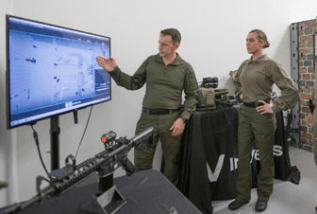Gamification In The Public Market
Gamification involves people at an emotional degree, which is far more effective than normal transactional interaction approaches.
— Brian Burke, Gamify: Exactly How Gamification Motivates Individuals to Do Extraordinary Points
Government training has actually never been much more critical or a lot more intricate. From energetic shooter preparedness to cybersecurity readiness, public servants are progressively contacted us to browse high-stakes scenarios where choices can have life-or-death effects. Standard training methods like fixed discussions, thick manuals, or infrequent workshops usually stop working to involve or prepare individuals for the vibrant obstacles they face.
Get in gamification: the application of video game layout principles to non-game contexts. In government training, gamification is more than a buzzword; it’s a tried and tested technique that enhances interaction, enhances knowledge retention, and builds real-world readiness. Whether it’s making use of Increased Reality to mimic emergencies, producing significant games for catastrophe action, or immersing cyber teams in risky attack circumstances, federal government companies are embracing gamified discovering to change training right into a hands-on, high-impact experience.
Allow’s discover just how three popular instances– DHS’s AR-based active shooter training, FEMA’s major games, and the ITU’s Cyber Ranges– demonstrate the power and possibility of gamification in the public field.
Examples Of Gamification In Government
DHS: Enhanced Truth For Energetic Shooter Educating
Through the National Urban Security Innovation Research Laboratory (NUSTL), the U.S. Division of Homeland Protection (DHS) has actually deployed Augmented Reality (AR) systems to support active shooter reaction training. [1] These systems overlay digital dangers and things onto real-world environments, transforming a normal classroom or workplace right into a dynamic training ground. Trainees relocate with physical spaces while replying to digital simulation, all offered in actual time via AR headsets or mobile devices.

Picture from dhs.gov [1]
Why It Functions
AR gamifies the atmosphere itself, giving immersive feedback loops that resemble real-life stress factors. Participants must evaluate threats, make decisions, and connect under pressure– just like they would certainly throughout an actual emergency situation. This hands-on, scenario-based training enhances situational awareness and improves retention much beyond standard lecture-based formats.
The result? Initial responders leave with muscle mass memory and confidence that static drills seldom give.
FEMA: Serious Gamings For Calamity Reaction
The Federal Emergency Situation Monitoring Company (FEMA) utilizes significant games– interactive, scenario-based simulations– to prepare public authorities for all-natural calamities and intricate emergencies. [2] One instance is FEMA’s Emergency Monitoring Institute’s Virtual Table top Exercises (VTTX), which enable individuals to role-play catastrophe scenarios in a digital environment. Whether collaborating a cyclone discharge or replying to a chemical spill, players choose, allocate sources, and adjust to altering conditions.
Why It Functions
Serious games reinforce systems thinking, allowing individuals to see exactly how their decisions effect others in genuine time. They likewise promote cross-agency cooperation, since gamers need to function as teams to deal with diverse difficulties. With integrated scoring, time constraints, and post-game comments, these simulations develop an engaging learning experience that reflects the complexity of real-life crisis administration.
FEMA’s use of gamification sustains not just preparedness but likewise vital representation, enabling leaders to evaluate their methods and boost them before a disaster ever before strikes.
ITU: Cyber Ranges And International Hazard Response
The International Telecommunication Union (ITU)– a UN firm– utilizes Cyber Varies to educate national, local, and international cyber feedback teams on just how to face digital hazards like ransomware, DDoS strikes, and crucial framework hacks. [3] These gamified simulations place participants in a virtual environment where they need to protect networks, recognize susceptabilities, and contain strikes under time pressure.

Photo from itu.int [3]
Why It Functions
Cybersecurity hazards progress rapidly, and typical “checklist” training is insufficient. Cyber Varies create high-fidelity simulations that resemble the intricacy of modern cyber warfare. Gamification components– scoring systems, substitute foes, real-time incident accelerations– drive interaction and develop the practical skills needed for contemporary digital defence.
What makes ITU’s method specifically effective is its collective global emphasis. Teams from different countries can participate in shared simulations, advertising common requirements, quick skill-building, and international cybersecurity resilience.
Why Gamification Issues For Government Training
These examples disclose a bigger fact: gamification isn’t just about enjoyable– it has to do with function. In high-stakes areas where lives, safety and security, and public trust get on the line, gamification deals:
- Involvement– Interactive situations enhance student motivation and decrease cognitive fatigue.
- Retention– Gamified training turns on several discovering techniques (aesthetic, acoustic, kinesthetic), boosting memory and understanding.
- Comments– Real-time racking up and debriefs provide workable insights for students and leaders.
- Versatility– Simulations can be customized for diverse audiences and changing risks.
- Collaboration– Team-based gameplay promotes cross-functional control and interaction.
As modern technology develops and public obstacles grow even more complicated, gamification continues to play an essential duty in preparing federal government experts– not just to find out, but to lead in situation.
From Augmented Reality in law enforcement to calamity reaction games and cyber war simulations, gamification is no longer a future fad; it’s a present critical. For agencies seeking to build resistant, prepared, and nimble teams, it’s time to boost the method with game-based discovering.
References:
[1] Enhanced Fact (AR) Training Equipments for First Responders
[2] Major video games in FEMA Regional Feedback
[3] CyberDrills

